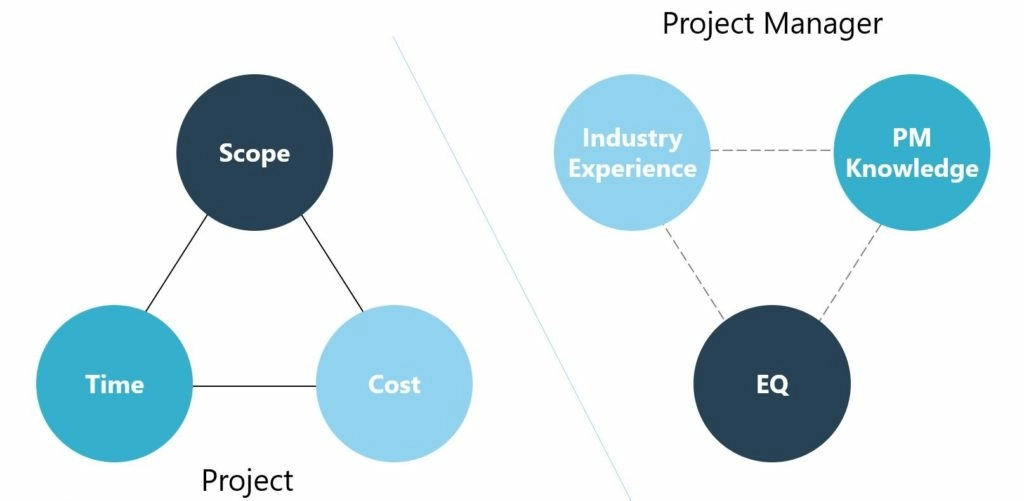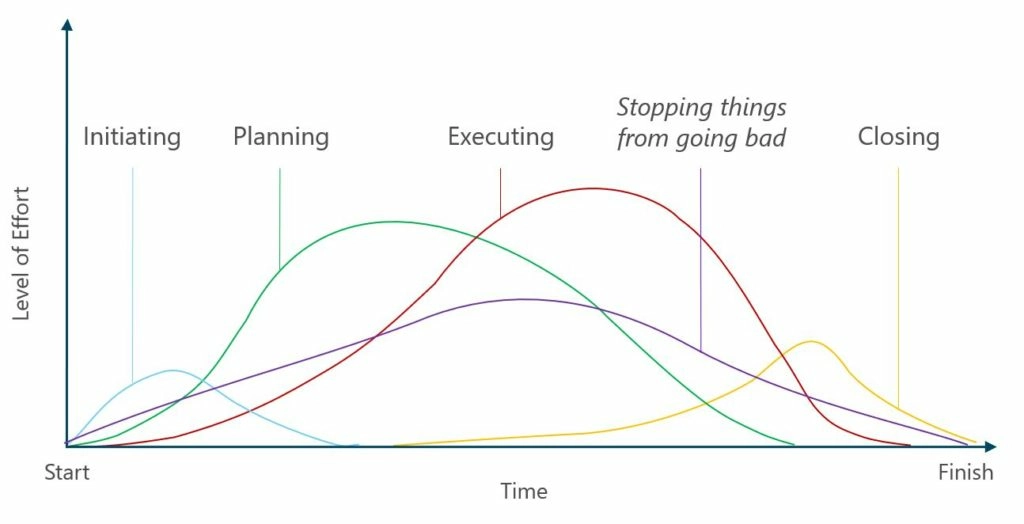There are many frameworks, methods, and tools published and available to us to help with successful project delivery, but these should support our experience as Project Managers, not define it. Experience helps us understand where to focus our time, where issues will lie, and how to best navigate the uncertainty of our projects. I’ve been
Experience helps us understand where to focus our time, where issues will lie, and how to best navigate the uncertainty of our projects. I’ve been known to mentor a few up-and-coming project managers and there have been a number of common themes that tend to appear when sharing my experience on successful project delivery.
Below are some of those themes presented as 10 tips to help make your projects more successful.
1. Know your triple-constraint
There are a large number of us are familiar with the old Proj
ect Triple-Constraint (or Iron Triangle) of Scope, Time and Cost.
I think there is a similar Triple-Constraint for Project Managers;
- Industry Experience – the more you have, the easier it is to understand the unique challenges your industry is presented with
- Project Management Knowledge – the more you have, the more frameworks and tools you have to fall back on
- Emotional Intelligence – the more you have, the easier you can relate to people
At the end of the day, it is people who deliver projects, not the tools, policies, or certifications you have. So I think the power of Emotional Intelligence, outweighs the other two constraints. Learn how to read people. Learning about human behavior is (hopefully) a life-long process, and if you’re really good at it, you’ll stand out among your peers in a big way.

2. Stay focused
Know your organisation’s project management framework, and use it. Understand each phase;
- What you need to enter the phase
- The purpose of the phase
- What you need to exit the phase
This will give you the structure you need to keep progress moving towards that successful project delivery. Many projects stall because a critical item was missed from an earlier phase.

3. Know the reason your projects exist

All organisations exist to deliver it’s vision, values, goals, and stra
tegy. They do this through change and they deliver change through projects.
Never lose site of what business problem or opportunity your project is addressing, and why this is important for your business. If you cannot make that connection, then maybe the project you are working on is not a valid project.
If you are looking for inspiration, take a look at Simon Sinek’s TED Talk on How great leaders inspire action. He reinforces the power of ‘Why’, and you should be able to relate this to your project.
4. Tell a story to sell a project
Everyone likes a good story, and a good Business Case or Project Charter should read like one. These documents exist to present a problem and sell a future state. You cannot sell a future state if you do not present the problem first.
Below is a good story framework you could adopt within your initiation document;
- Once upon a time (This is context of what we do)
- Then one day (this is the problem)
- Because of that (this is the impact)
- In the future, it means (this is how great things will be after the project is completed)
Further to this, ‘show’ is a lot better than ‘tell’. Include photos, models, physical examples of what you are conveying.
5. Drink coffee!
…or tea, or juice, or water.
Make time with People. As I alluded to above, it is people who create projects, deliver projects, and receive the change that the project creates, so talk to them. Break the ice, understand their views, discuss your thoughts, get feedback.

Ask each of your key stakeholders the following two questions;
- What do you want from me as part of your role on this project?
- What do I want from you as part of my role on this project?
They will appreciate your interest in the project, and more importantly, your interest in them. You may get some interesting answers!
6. Mind-maps are gold
Mind-maps offer us the power to translate our sometimes complex projects into a visual picture. With a picture being worth a thousand words, it can add a lot of value to your project by presenting everything on one page. I often create my project Work Breakdown Structures (WBS) in mind-maps. This helps provide me and other stakeholders with focus and clarity about what is needed for a successful project delivery. A good way to identify and assign resources as well!
7. Know how much more money there is to spend
All projects managers should know what their project budget (Budget at Completion) is. The great project managers know how much they have spent to date (Actual Cost), and how much money they need to complete the project (Estimate to Completion). If your estimate to completion is more than your remaining budget, you need to start having a conversation with your sponsor. If you don’t know how much money you have left, then you will likely be having that conversation after it is too late.
One Executive Sponsor once said to me, “A good Project Manager is forward facing. They look at the horizon and see what is in front of them. They constantly assess if they have the right resources today to face the uncertainty tomorrow. If they know how much money is left to spend versus how much money they need to spend, then that is the sign of a good project manager.”
8. Be a Hero
As a project manager, you naturally spend most of your efforts in planning. Working out the what, when, why, where, who and how of the project. Once the project is underway, and all is going well, I see some project managers manage projects by simply holding weekly meetings, and running through actions and discussing progress.

That is a fairly boring approach to project management. You have got to do more than that.
Don’t just follow-up on actions or tasks you are waiting on team members to complete. Ask how you can help!
Your role is to be a Servant Leader – You run interference. Feed and water the team to allow them to focus on what they are good at. Sometimes you have more authority than your team members, or maybe your voice to senior management carries more weight. If your team members are frustrated by politics, lack of training, too many projects, lack of decision making, then step in to help;
- Ask them what action you could do to help the most
- Prioritise work items, so they are only working on the essential at this point in time
- Just listen, that itself can be a huge help.
9. Present & write for the reader
As Project Managers, our minds are constantly in the detail of delivery. This doesn’t help us when it comes time to writing status reports and presenting at Steering Committees.
We need to think more like a Sponsor, like a Senior User. Understand your audience and always write for their needs.
Using templates should be a good starter, but only if somebody has designed them based on the reader, not the writer.
If you don’t work in a mature organisation, or you would like a source of templates – visit projectmanagement.com or email us and we’ll send you a collection to use as a foundation.
On a related note, documenting Project Charters, Plans, Work Breakdown Structures, Risk Registers, Change Requests, Status Reports all takes time. And a lot of it. But if nobody is reading the contents then what it s the point? Ask your Sponsor or Steering committee what they want to see, what they have liked about what other project managers have provided in the past. Get feedback, and get it more than once. Don’t assume the conversation you had on day one is something that will not change throughout your project.
10. Find a Yoda
Don’t feel you need to know everything just because you are the project manager, and don’t walk blindly into any new project. Learn from others!
- If you have a PMO, speak with them.
- If you have other project managers, speak with them.
- Maybe your Sponsor can assist. Maybe another senior manager can.
Seek out a mentor. Do or do not. There is no try. Apply the same confidence to your role.

Adventure. Excitement. A Jedi craves not these things. A project manager he or she does.
I hope you’ve found the 10 tips above useful for successful project delivery and if you’d like to stay in touch, please subscribe to our newsletter:
Best of luck with your projects!
Mike.
Not quite what you’re looking for?
Other blogs
of interest






